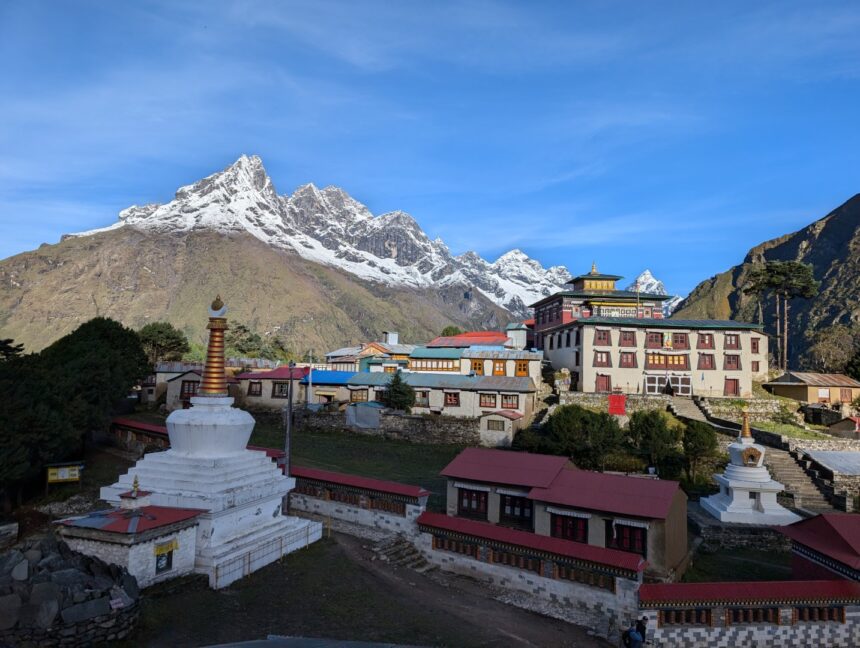Nepal is a beautiful country known for more than just trekking, mountaineering, and family vacations.
Nepal is also famous for meditation retreats, cultural trips, and spiritual quests.
Home to numerous religious temples, stupas, and monasteries, Nepal holds special significance as the birthplace of Lord Buddha.
Each year, pilgrims from around the world visit Nepal to explore and pay homage to its monasteries.
Monasteries in Nepal are special places where visitors can meditate, unwind, relax, and learn about Buddhism.
These serene retreats are often located in remote areas, far from the hustle and bustle of city life.
One notable example is the Tengboche Monastery, situated in the Khumbu region of Nepal, nestled in the mountains.
The Tengboche monastery is a popular stop for those trekking to Everest Base Camp.
Here are some beautiful monasteries that are must-visit destinations while traveling in Nepal
Pungyen Gompa
Located in the scenic Manaslu region, Pungyen Gompa is a secluded Buddhist monastery that captivates visitors with its tranquility and spectacular mountain views.
Situated near the glacial moraine of Mount Manaslu, this gompa holds special significance for the local villagers and serves as an important spiritual retreat.
Pungyen Gompa offers a unique experience, being somewhat hidden and less visited than other monasteries, making it an appealing destination for trekkers and spiritual seekers alike.
The quiet solitude and the breathtaking views of the snow-covered Manaslu massif create an atmosphere of profound peace and reverence.
The trek to Pungyen Gompa is a rewarding highlight for those on the Manaslu Circuit Trek. This half-day detour from the main trail may be challenging due to its steep ascent, but it treats trekkers to sweeping views of the Manaslu Glacier and the surrounding Himalayan peaks.
This monastery offers an opportunity to experience the simple, spiritual life of the monks who live there and to learn about local traditions that have remained largely untouched by modern influences.
The gompa is often adorned with prayer flags fluttering in the wind, adding a vibrant contrast to the stark mountain landscape and reminding visitors of the region’s deeply rooted Buddhist heritage.
Kopan Monastery
Kopan Monastery is a popular destination for both local and international travelers.
It is one of the most beautiful and revered Buddhist pilgrimage sites located in the Kathmandu Valley.
What makes Kopan especially famous is its dedication to teaching Buddhism to Western visitors.
People from all over the world come here to attend courses, study, and practice Buddhism and meditation in the serene spiritual atmosphere.
The monastery features several stupas, statues, prayer wheels, a debate hall, and holy relics, making it a rich and inspiring environment for those seeking spiritual growth and knowledge.
White Gumba (Amitabh Monastery)
White Gumba, also known as Seto Gumba or Druk Amitabh Monastery, is a well-known spot in the Kathmandu Valley.
It offers spectacular views of the sunrise and sunset, as well as breathtaking vistas of the Kathmandu valley and, on clear days, the mountain range.
White Gumba monastery is a stunning example of Tibetan architecture, adorned with many murals, statues, and paintings.
Situated at an altitude of 1500 meters, it is an excellent destination for sightseeing, religious purposes, and hiking.
White Gumba attracts both domestic and international tourists, who come to appreciate its beauty and spiritual significance.
Neydo Tashi Choling Monastery
Neydo Tashi Choling Monastery is renowned for its enormous Amitabha Buddha statue which is the largest in Nepal.
This monastery is an ideal place for meditation and experiencing monastic life.
This monastery is housing nearly 200 monks who study and practice Buddhism.
Visitors can participate in activities and gain insights into their daily routines.
Nearby, you can visit the Asura Cave, where Padmasambhava, also known as Guru Rinpoche, meditated and attained the highest realization of Buddhism.
The surrounding Hattiban Forest offers several nature walking options, from full-day hikes to easy, short walks, making it a perfect place for both spiritual and natural exploration.
Pullahari Monastery
Pullahari Monastery is in the foothills north of the Great Boudhanath Stupa.
The expansive monastery grounds include two religious buildings, monks’ quarters, gardens, vegetable patches, and living quarters for visiting students.
Designed by an American architect who became a monk, Pullahari Monastery is open to all visitors.
The monastery symbolizes beauty and offers secluded serenity, making it a peaceful retreat for everyone, regardless of religious beliefs.
Visitors are often moved by the tranquility and beauty of the architecture and landscape.
Additionally, the Pullahari monastery offers a stunning 360-degree view of the Kathmandu Valley, enhancing its appeal as a place of reflection and relaxation.
Jamacho Gumba
Jamacho Gumba, meaning “celebration of the hill,” is a popular day hike destination in Kathmandu, valued for both its religious and scenic significance.
It serves as a pilgrimage site for devotees of Guru Rinpoche and Acharya Nagarjuna.
Located at the top of Shivapuri Nagarjun National Park, the Jamacho monastery offers splendid views of the Kathmandu Valley and the Himalayas, including the Langtang and Everest ranges.
Local and foreign travelers can hike to Jamacho Gumba not only to explore the monastery but also to enjoy the panoramic views from the viewpoint.
The well-maintained trail weaves through a dense forest preserved by the Nepal Army and is suitable for beginners.
The hike is accessible in every season.
Jamacho Gumba uniquely combines cultural significance, beautiful hiking trails, and stunning vistas, making it a must-visit destination for anyone in Kathmandu.
Nagi Gumba
Nagi Gumba, also known as Ani Gumba, is a Buddhist monastery located on a hilltop
It offers wide views of Kathmandu City and occasional glimpses of the Langtang Himalayas.
Nagi Gumba is an ideal destination to escape the hustle and bustle of Kathmandu and is popular for day hikes.
This monastery is unique because it is run by nuns and is home to about 200 nuns who practice Buddhism.
The serene environment and panoramic views make Nagi Gumba a peaceful retreat and a popular destination for both local and international visitors seeking tranquility and spiritual solace.
Khawalung Monastery
Khawalung Monastery offers not only religious education through basic and advanced courses but also provides free food, clothing, and medical care for all its monks.
Inside the Khawalung monastery, you will find a statue of Guru Rinpoche flanked by Vajrasattva on one side and Chenrezig on the other. There is a very precious statue of HH Dilgo Khyentse Rinpoche.
The architecture of Khawalung Monastery is extensively detailed and inspired by traditional Buddhist styles and structures, making it a visually stunning and spiritually enriching place to visit.
The combination of its educational offerings, supportive environment for monks, and beautiful design makes Khawalung Monastery a significant and inviting destination.
Thrangu Tashi Yangtse Monastery (Namobuddha)
Thrangu Tashi Yangtse Monastery, also known as Namobuddha Monastery, is a prominent Tibetan Buddhist monastery located southeast of Kathmandu, Nepal’s capital.
It serves as a significant center for tourism.
According to legend, 6000 years ago, Prince Mahasatwo (Ngingdui Tshenpo) encountered a starving tigress and her five cubs.
To save them, he cut his body to draw the tigress with his warm blood, sacrificing himself.
The tigress consumed the prince, leaving only his bones, which were later brought back to the village and buried in a tomb that became the stupa of Namo Buddha.
The monastery features a Tibetan Medical clinic, a monastic college, a smaller shrine hall, and a school for young monks, with over 250 monks studying Buddhist philosophy.
Significant festivals such as Kartik Purnima and Buddha Jayanti are celebrated here.
Visitors can reach Namobuddha by taxi or private car, but for those seeking adventure, hiking from Bhaktapur or Dhulikhel is an excellent option.
Tengboche Monastery
Tengboche Monastery is situated at an altitude of 3,867 meters on the main Everest trekking route from Lukla to Everest Base Camp.
It is nestled amid a stunning Himalayan panorama, with the majestic Ama Dablam peak as its backdrop.
Tengboche is the most prominent and largest monastery in the entire Khumbu region.
The monastery is well known for the Mani Rimdu festival, a significant cultural and religious event.
The easiest way to reach Tengboche Monastery is by taking a regular flight to Lukla and then walking for three days along the scenic trekking route leading to Everest Base Camp.
This journey offers trekkers an unparalleled view of the Himalayan landscape and a chance to experience the unique spirituality of the region.
Rinchenling Monastery
Rinchenling Monastery is a stunning Tibetan Buddhist monastery located in Halji Village, one of three small communities in the Limi Valley.
Perched at approximately 3,600 meters, it is one of the highest temples in the world.
Renowned for its ethereal beauty, this ancient monastery suffered significant damage in 2011 due to the burst of a glacial lake and remains susceptible to flood damage.
The monastery is a three-story structure with a rectangular open courtyard.
It comprises assembly halls, a library, monks’ quarters, a kitchen, and a storeroom, with the upper two stories dedicated to religious functions.
Accessible via the Limi Valley trekking trail from the nearest airport in Simikot.
Reaching Rinchenling Monastery involves catching a flight from Kathmandu to Simikot and then embarking on a six-day trek to the monastery.
This journey offers trekkers not only a glimpse of the monastery’s beauty but also an opportunity to experience the breathtaking landscapes of the Limi Valley.
Narsingh Monastery
Narsingh Monastery is a Buddhist monastery situated in the rural Baragung Muktichhetra municipality of the Mustang District in Nepal.
Positioned to the north of the Muktinath temple, it is also known as the “temple of 1,000 lamps.”
The monastery houses a statue of Guru Padmasambhava (Guru Rinpoche) along with Tibetan tantric deities Drag Po on the right and Seng Dong on the left.
Interestingly, Hindus also worship in this monastery, regarding its deity as the Narasimha avatar of Vishnu.
This monastery is constructed of stone and mud masonry and is believed to be approximately 1,250 years old.
In 2018, it underwent renovation due to water leakage, costing Rs 28.5 million.
Narsingh Monastery stands as a significant religious and cultural landmark in the Mustang District, attracting both Buddhist and Hindu devotees alike.


